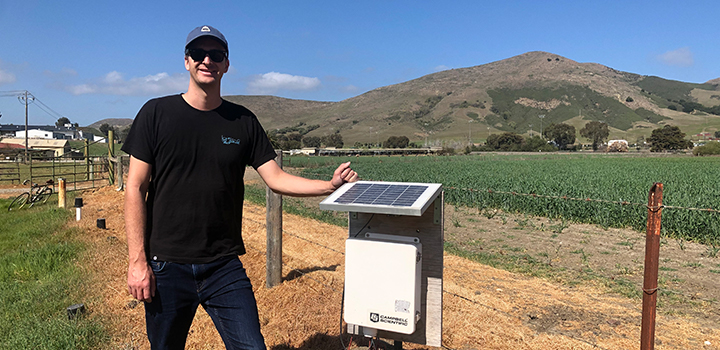Characterizing Low Permeability Soil Using Triaxial Permeability Chamber
Brian Whetsler
 Project Description
Project Description
I will be using a triaxial permeability chamber to determine the saturated hydraulic conductivity of low permeability soils from both Swanton Pacific Ranch and Cambria, California. Hydraulic conductivity values are difficult, and sometimes not possible to achieve using a conventional soil flow cell when dealing with low permeability soils. A triaxial permeability chamber applies pressure to the soil sample to simulate in-situ conditions which results in the flow of water through the soil pore spaces. The main goals of this project are to fill data gaps from a prior graduate student’s research surrounding Swanton soils and to use the triaxial test techniques to better characterize soils in California. The information gained using these tests will provide strong data for calibrating groundwater models used to predict the behavior of groundwater basins, specifically those characterized as medium and high priority under California’s Sustainable Groundwater Management Act (SGMA).

What Inspired Me
During my undergraduate studies I worked alongside Dr. Bwalya Malama conducting groundwater research at various sites around the campus and other satellite properties. When I was admitted to the master’s program in the Fall of 2019, I knew I wanted to work on a hydrology related project. I found my experiences working with Dr. Malama and the hydrology classes I took during my undergraduate challenging, thought provoking, and worth further research. I have chosen to do a professional project over a thesis because I do not foresee myself pursuing a PhD, and the professional project is a short, four quarter program which is tailored for individuals in the work force who are seeking a competitive edge. That being said, when I started I was not sure what specific research I wanted to pursue within the realm of hydrology.
Project Status
Fall 2019
It was a bit of a shock to get back into school in fall after working for nearly a year and a half. Coming into the master’s program I knew I wanted to pick a project quickly so that I could start planning my next steps. During orientation a group of professors and local organizations gave the incoming students an idea of projects that were available to get involved with. Since I knew I wanted to focus my studies in hydrology, I gravitated toward a pitch by the Creek Lands Conservation, a non-profit out of Arroyo Grande, California. The goal of the project was to map the baseflow trends of Stenner Creek, a tributary to San Luis Obispo Creek, to help guide land and water resource management decisions to increase the annual volume of water reaching San Luis Obispo Creek.
I was able to get a lot of research on my project done in the Research Planning course. We were shown how to properly put together an annotated bibliography and literature review. We were also tasked with presenting our literature review findings and our overall research goal in concise, five-minute professional presentations. All of this helped me consolidate all of the reading I had done relating to my project into a workable hypothesis.
Winter 2020
During the first week of winter quarter I met with my advisor, Dr. Malama, to talk about project details with regards to gathering field equipment to measure Stenner Creek baseflow. We ran into a bit of a snag because the equipment we needed is expensive and the project does not currently have any funding behind it. Dr. Malama suggested that I shift my focus to one of his ongoing projects that can be done in the lab with equipment he already had. Given the short period of time we must complete our project and degree in, I decided to take Dr. Malama’s advice and change my project. This meant that all the work I had done last quarter in Research Planning was now out the window and I was back to square one. This was obviously a bit of a stressful decision, but I expected speedbumps like this as a grad student. The work is fast paced, so there is no time to worry, just time to do.



 Open: M - F 8am - 5pm
Open: M - F 8am - 5pm